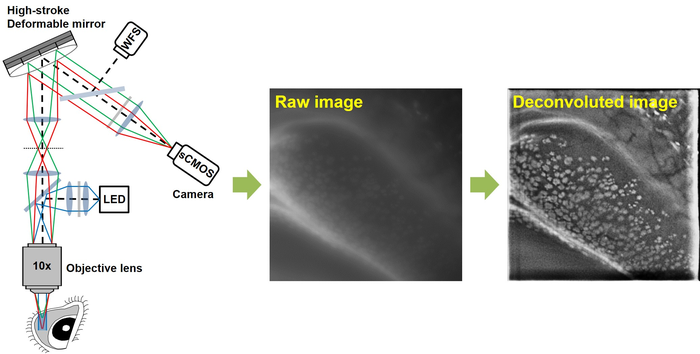Article
Study examines high performance microscopy for non-invasive conjunctival goblet cell examination
Author(s):
A team of investigators from Pohang University of Science and Technology has found that conjunctival goblet cell examination is important for the precise diagnosis and effective treatment of ocular surface diseases; however, CGC examination has not been possible until now due to lack of non-invasive devices.
Conjunctival goblet cells (CGCs) are specialized epithelial cells secreting mucins to form the mucus layer of tear film. The mucus layer spreads the tear film on the ocular surface for protection. The dysfunction and death of CGCs causes tear film instability and is associated with various ocular surface diseases including the dry eye disease (DED).
Image acquisition and image processing using the mouse conjunctiva as an example. (Image courtesy of POSTECH)

Because DED is a multifactorial disease with multiple causes, it is important to find the causes and disease status. Therefore, CGC examination is important for the precise diagnosis and effective treatment of ocular surface diseases; however, CGC examination has not been possible until now due to lack of non-invasive devices.
A Pohang University of Science and Technology (POSTECH) research team led by Ki Hean Kim, PhD, and doctoral candidates Jungbin Lee and Seonghan Kim (Department of Mechanical Engineering), in collaboration with Hong Kyun Kim, MD, and Byeong Jae Son, MD, (Department of Ophthalmology) of Kyungpook National University and Chang Ho Yoon, MD, (Department of Ophthalmology) of Seoul National University, has developed a high-performance microscopy system for non-invasive CGC examination in patients. Recognized for technical advancement and potentials, this research has recently been published in IEEE Transactions on Medical Imaging.1
Earlier in 2019, the research team had discovered for the first time that moxifloxacin, an FDA-approved ophthalmic antibiotic, stains CGCs, and demonstrated high-contrast CGC imaging by using moxifloxacin as a cell labeling agent. However, CGC imaging in humans was impossible due to various limitations of conventional microscopy techniques such as shallow depth-of-fields (DOFs) and slow imaging speeds.
To overcome these limitations, the research team developed a high-speed extended DOF microscopy which had a 1 mm DOF (25x DOF extension) and 10 frames per second imaging speed. A deformable mirror was used in the system to axially sweep the imaging plane and to capture CGCs on the arbitrary tilted conjunctiva in single frames. The acquired images contained both in-focus and out-of-focus information, and the deconvolution was used to filter the in-focus information only. Using the new system, the researchers were able to demonstrate real-time, large-area CGC imaging in live mouse and rabbit models.
“The newly developed imaging system can obtain high-resolution in-focus images of CGCs in live animal models and is also applicable to humans, Ki Hean Kim noted. “Going forward, we will develop a device for imaging patients and then run clinical trials to test the feasibility of non-invasive CGC examination in the diagnosis and treatment of ocular surface diseases.”
This study was conducted with the support from the Samsung Research Funding and Incubation Center (Project number SRFC-IT2101-05).
Reference:
1) Ki Hean Kim, PhD, et.al; Moxifloxacin-Based Extended Depth-of-Field Fluorescence Microscopy for Real-Time Conjunctival Goblet Cell Examination. IEEE Transactions on Medical Imaging; published Feb. 15, 2022; doi 10.1109/TMI.2022.3151944
Newsletter
Don’t miss out—get Ophthalmology Times updates on the latest clinical advancements and expert interviews, straight to your inbox.




